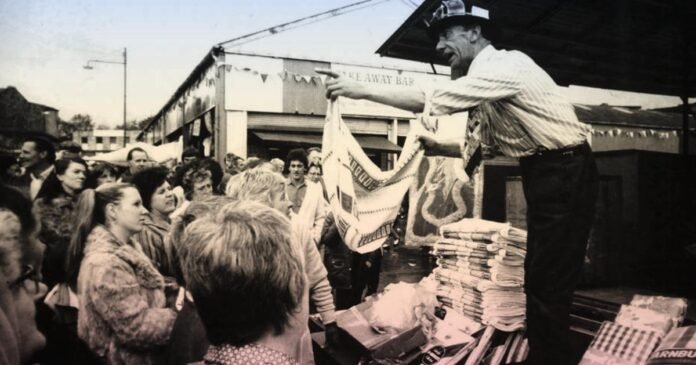In the late 18th century, traders often congregated in Glasgow’s East End, hawking bric a brac and other sundries.
The word ‘Barras’, short for wheelbarrows, refers to the carts traders would pull around the city and sell their wares from.

She moved with her mother to Glasgow as a child, settling in Bridgeton. In 1902, she married fruit seller James McIver.
In 1921, now in middle age, the couple founded The Barras Market on the corner of Kent and Moncur Streets, providing traders with a base from which to hawk goods, as well as a place to rent barrows.
Five years later, weeks of heavy rain forced the McIvers to build an open shed to keep traders and customers dry. By 1928, the shed was enclosed on all sides.
After James McIver died in 1930, Maggie ran the business for the next three decades.
As historian Peter Mortimer told The Herald in 2021: “Maggie was burdened with capital gains debts, nine children and a business to run. James dying put additional strain on her.
“But she was a resolute woman. She had the market, where it used to be said you could get ‘anything from a needle to an anchor,’ as well as the ballroom.

As the story goes, Maggie hosted an annual Christmas meal for the hawkers selling wares out of The Barras in the local St Mungo’s Halls.
In 1934, she discovered the venue was already booked, so she built her own – the Barrowlands Ballroom, which opened on Christmas Eve.
A revamp in the 1960s after a disastrous fire saw the ballroom rebuilt. Twenty years later, the venue was fitted with its iconic neon sign, subsequently playing host to generations of music legends.
Scottish icon Jon Fratelli told The Herald about the mystique the Barrowlands held for him as a young musician.
In 2022, he said: “I think we would probably all agree that when you’re 19 years old the idea of playing the Barrowlands is the summit.
“Anybody that you saw that was playing in a stadium, somewhere huge, it didn’t seem attainable, it was unreal. It was something that only happened on TV. But playing the [[Barrowlands]]. There was something more concrete and solid about that.”
“I think musicians and anybody creative in general, actually, have this streak of self-doubt. When you play the Barrowlands and people really start hearing your music, you retain that first rush if you’re lucky enough to get it. It dampens down, but it never really goes away. It’s still the top for me.”

Actor Gavin Mitchell, aka Boaby the Barman from Still Game, grew up in Glasgow during the 1960s and 70s.
He told The Herald in 2022 that The Barras is his favourite place in the city.
Mitchell said: “I’ve got a wee dog, so we walk a lot. One of my favourite things to do is wander down The Barras”.
“I still love popping by Danny’s Hot Donuts. I think the markets are the heart and soul of Glasgow. It takes things back to who you are. I used to go to the market with my granny on a Saturday. I notice when I still go down there, the way people talk, it’s heartfelt and it’s real and I love that.”
Fond childhood memories aside, by the late 1990s, footfall had declined and stalls were emptying as police began to crack down on unscrupulous traders.
In 1997, a series of raids uncovered £8m in stolen and counterfeit goods at the market, and 28 people were arrested in one of the largest raids in Strathclyde Police history.
This was eclipsed a year later in November 1998, when 43 people were picked up on suspicion of dealing in stolen or fake items. £14m in goods was recovered, including £12.4m of counterfeit CDs, £17,000 of stolen cigarettes, rip-off Armani and Ralph Lauren clothing.

“This particular operation was planned as part of the force-wide efforts against housebreakers who prey on private households and businesses. Our efforts against these criminals are continuous.”
Raids continued throughout the early 2000s, and in 2009, it was reported that Barras traders had appealed to the council for support amidst criminal gangs who had moved into the area.
In 2016, police seized an estimated £30m in counterfeit goods, arresting 100 people in a series of raids dubbed ‘Operation Salang.’
Read more:
Yet, a decade later, things are on the upswing.
Despite concerns over the future of the venue, the early 2020s have seen a renaissance at the market, as young traders peddling sustainable fashion and trendy food options have set up shop among the stalls of older generations.
From Hong Kong waffles and fresh pressed juice to record shops and vintage cowboy boots, The Barras has something for everyone.
More than one hundred years after it was founded by the McIvers, the market continues to be a popular destination for local residents, students, and visitors from across the world.
Let’s see what the next hundred years hold.






